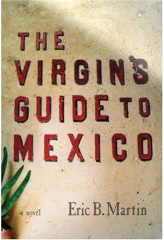 |
 |
 |
 Entertainment | Books | June 2007 Entertainment | Books | June 2007  
Harvard or Mexico? Teen Chooses Past Over Present
 Reviewed by Lisa Teasley - NYTimes Reviewed by Lisa Teasley - NYTimes


| The Virgin's Guide to Mexico
by Eric B. Martin
MACADAM/CAGE
238 PAGES, $25 |
In present-tense, staccato voice and blunt, rhythmic prose, Eric B. Martin, in his third novel, "The Virgin's Guide to Mexico," follows Alma Price, a 16-year-old rich, suburban Texan, on her journey to her maternal roots in Mexico. She has put off Harvard to embark on this quest, and like Shakespeare's Imogen of "Cymbeline," Alma disguises herself as a boy for the trip.

Trying to find the grandfather she'd never met - the one her father didn't know existed - she hooks up with a band of American boys, hoping to blend in with them on a series of adventures. Together they soak up culture with the locals at weddings, clubs, whorehouses and such. Though frightened and intimidated throughout to be a young white-identified girl in a country that scares her just a hair less than the African American side of town in Austin, Alma still manages to maintain her virginity and self-image for quite a while. In this paragraph, she reveals simultaneously her self disdain and vulnerability in Mexico:

"She might be nominally half Mexican but she doesn't look it, she looks weird for real and besides they can smell the Westlake on her. She stinks. And they stink too, they're not the Mexicans she's looking for. She knows what the real Mexico can be, she reads, it's more than uneducated peasant painters and roofers and gloopers of cement."

As she makes her way through the psychological labyrinth of "the real Mexico," her revelations are hardly more learned. However, more disappointing is Part Two, when we find Alma's mother, Hermelinda, sharing views that are not a whole lot more complicated. Martin switches to the past tense for the introduction of Hermelinda, who is 40, beautiful and reminiscing about accompanying her husband, Truitt, to chase their daughter down in Mexico. For all Hermelinda went through to leave Mexico, she gropes to find why Alma would put off Harvard to go back. Truitt is Hermelinda's ex in this very short reminiscence, and there is a lot of longing, loss and burning in her heart. The narrative swiftly returns to what is present to the reader - the search for Alma, who is still in the thick of running - and then in broad strokes it portrays Hermelinda's mixed feelings for herself and her country:

"What a beautiful town this was. She could walk this street with Alma's arm linked through hers. The only thing Hermelinda recognized was the way people looked at her. The way Mexican eyes ate a stranger. Burned her from her pupils to her shoes. Breasts. Hips. Legs and neck. What she had forgotten about Mexico was the sex, the way it lingered everywhere. It was eight o'clock in the morning but every man she passed wanted to spread her legs. The women wanted her to stay away from their men and wanted her to know they saw deep down she was still just poor dark Indian trash no matter how much her sunglasses cost or what anyone said."

Though Martin could have spent more time developing subtleties in Hermelinda's voice, he often switches to Truitt's point of view, even within a single paragraph. As jarring as these switches are, it's certainly necessary to know how Truitt views the world, why he is the kind of man who speaks derogatively of his daughter, his wife, women, Mexicans and anyone else in his way. In this particular passage, Truitt reveals why he calls Hermelinda "Lindy," how she attracted him and why he resents her for becoming more Mexican as they travel farther into her country:

"She'd been Mexican for a week or two, when they first started dating, but after that she was just smarter and more sure and better-looking than everybody else. You wanted to do anything for a girl like that, Mexican or whatever, to grab the tech cash rolling out from California and flash-flooding uphill through the streets of Westlake, to marry her, to keep her, to give her what she wanted even though it couldn't last."

Naturally, when she reaches Mexico City, Alma is relieved to find the intellectual kids, but also quite naturally, the potential danger is far from over. By the end, we discover why Martin deemed it necessary to create Alma's father as a true Texas cowboy. And in that way Truitt is only a tool, much like Hermelinda and her story. Where protagonist Alma has hints of great texture - hopefully as infinite as the psyche of the terrain that is Mexico - this is never realized. And the parents, whom Alma is trying to escape, end up only weighing her down in the clunk of the plot.

Lisa Teasley is the author of the novels "Heat Signature" and "Dive," and the award-winning story collection "Glow in the Dark," published by Bloomsbury. | 
 | |
 |



